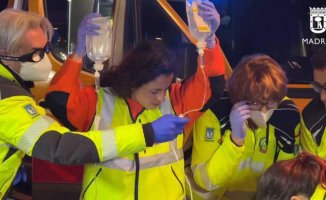On Wednesday, at mid-morning, the news broke: Arrested as the alleged author of the letters with explosives addressed to Sánchez and Robles. A retiree from Aranda de Miranda de Ebro named Pompeyo caused media alarm at the beginning of December last year by sending six letters with pyrotechnic material to politicians, institutions and companies that had a common link: support for Ukraine against Russia . At that moment, all the police machinery was launched to try to reach the author.
There was no time to lose. A letter with explosives to the President of the Government was a sufficiently delicate matter to search for whoever was behind it even under the stones. Due to the type of recipients of the letters, it seemed quite evident that the motive was the role of Spain in the Russian invasion of Ukraine. Could the Russian secret services be behind it? or some pro-Russian group?
The first clue: the agents were able to partially detect a postmark from the Valladolid Automated Treatment Center. That's where you had to go. They analyzed the security cameras and it was possible to see that all the artifacts were processed in the same place; on different days.
It was time to go behind the envelopes. The investigators decided to do the route in reverse until they reached the delivery trucks. The routes followed by these allowed us to verify that the shipments could have left different external mailboxes in the town of Burgos.
They already had something: Burgos. The next clue they had to work with were the stamps stamped on the envelopes, “Disello cat. General” for 0.75 euros” and “Monte Santa Trega” for 2.70 euros. It was necessary to find out in which establishments this type of stamps could have been sold. And they found two tobacconists, where they could only have been purchased: both in the city of Burgos.
Little by little, the researchers were managing to narrow the margin of action. You just have to go to the two places and look for the security cameras to try to get it right.
Meanwhile, the line of envelopes should be followed. Its characteristics (DIN A5 format, size, shape of the flap, type of closure, folds, etc.) led them to the website that markets its online sales. The company provided a list of all the people who, by the approximate dates, had bought envelopes.
One by one, looking for someone in the Burgos area. "It was meticulous work until the fruits were finally obtained," explain sources of the investigation. And bingo!: they already had a name: Pompeyo González, residing in the town of Miranda de Ebro (Burgos). On November 5, he purchased 25 of these envelopes.
At that point it was time to track more online purchases. They found Amazon. Between June and July, this person had bought a kilo of pure potassium nitrate, wire with a wick, switches, copper filaments, and incandescent light bulbs; and between the months of October and November 2022, I purchase adhesive stickers, hinges, all kinds of screws, precision drill bits, stencils for drawing numbers and the alphabet, stencils for drawing numbers and letters of the alphabet, etc. The dates indicate that the alleged author of sending the letters acted in a planned manner so that his plan would turn out well.
“The comparison and scientific analysis of these purchased products and those used in the preparation of the envelopes and boxes containing the explosive substances allows us to state that” the white self-adhesive labels were the same; as well as the templates, the hinges, the drill bit and other gadgets, as explained by the judge of the National Court José Luis Calama in the unconditional prison order regarding the suspect.
Pompey had it all figured out and tried to hide his identity. For this reason, he simulated a letter that is not his on the envelopes with the addresses of the recipients. This is how the scientific police concludes: “An evident lack of spontaneity and sincerity, which is demonstrated by the construction system used, line by line, with a predominance of the versal format […] frequent stops, reconnections and corrections, all of them elements which may indicate an attempt to hide the usual style of writing.”
Back to the tobacconists. The agents requested the traffic of the telephones that passed through the area on those dates. They found eight IP (Internet Protocol) addresses that consulted all the web addresses of the organizations to which the envelopes with explosive substances were sent, such as the Ministries of Defense and the Presidency, Instalaza, and SatCen. And these IP numbers were associated with the connection from which Pompeyo González bought the materials online.
Police were closing in on the suspect, but there was still work to be done. The same genetic profile appears in the different traces of DNA found in the artifacts sent to different places. Corresponding to a male but was not in the databases.
So it was up to investigators to cross-check it with the suspect's DNA. For this, a surveillance device was established on him. On January 18, it was possible to remove a piece of evidence from a garbage bag that had been left in a container. The Scientific Police General Commissariat rummaged through that bag and a genetic sample appeared. His profile coincided with that which appeared on the stamps and on the different internal parts of the explosive devices.
All that remained was to prepare the device to arrest him and search his house. Inside there were remains of materials used for the explosives. They already had the main suspect in the terrorist threats: Pompeyo González, a 74-year-old retiree, resident in Miranda del Ebro, in which in his spare time he read pro-Russian pages and media.













